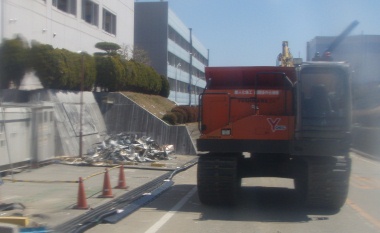Recovery operations have continued in line with recent days at Fukushima Daiichi, while a map has shown rubble to be the biggest source of radiation for workers on site.
The four wrecked units at the embattled power plant remain in the same relatively stable conditions as they have for around a month. Having lost cooling functions and gone on to suffer significant core damage, units 2 and 3 require Tokyo Electric Power Company (Tepco) to continue injecting fresh water at the rate of 6.8 cubic metres per hour.
The rate of water injection at unit 1 is slightly slower at 6.1 cubic metres per hour. Tepco is also injecting nitrogen to the reactor system to reduce the chance of a further hydrogen explosions. More than 12,400 cubic metres of the gas has now been injected - over double the amount originally planned. Tepco said it decided to continue the operation to further mitigate any risk.
Unit 1 remains the most difficult of the three. Core damage estimated at 70% may be inhibiting the flow of coolant water, leading to higher temperatures and pressures.
A test will be conducted tomorrow at unit 1 to help determine the true parameters of the reactor system, sensors for some of which may have been damaged during the accident sequence. Tepco will temporarily raise the speed of water injection from 6.1 to 14 cubic metres per hour and observe changes in reactor water levels, pressure and temperature as well as primary containment vessel pressure.
|
| Patches of rubble like this are the major source of radiation on site. Remote control operations to clear them up have filled 56 large containers |
Water injection operations are powered by external supplies from the grid and the connections that support this have now been cross-linked. Power for units 3 and 4 can now be directed to units 5 and 6 and vice versa, which would allow Tepco to switch power between the pairs alternately to maintain essential functions should the site be partially disconnected from the grid or again have problems with diesel generators. Separately the connection for units 3 and 4 is to be upgraded from 6 kV to 66 kV in a four-day project.
Radiation map
A survey of radiation dose rates at the site has revealed the highest to come from debris left on the ground after the explosions at units 1 to 4. Some rubble beside unit 3 is giving the highest dose rate of some 300 millisieverts per hour, while other debris patches are at 30-40 millisieverts per hour.
More generally, the dose rates at the edges of the site are less than 0.6 millisieverts per hour and increase towards the centre where they range up to about 10 millisieverts per hour. However, there are numerous and varying small areas with higher dose rates anywhere between 15 and 60 millisieverts per hour.
Water transfer pipes near unit 2 and the waste treatment facility feature high surface dose rates of 75-160 millisieverts per hour at various points. Levels in the air nearby are lower at 4.9-20 millisieverts per hour.
Highly contaminated water is being pumped from the basement of unit 2's turbine building, with about 1700 cubic metres transferred so far.
Exposures |
Researched and written
by World Nuclear News





_91467.jpg)
_47120.jpg)
_16439.jpg)






